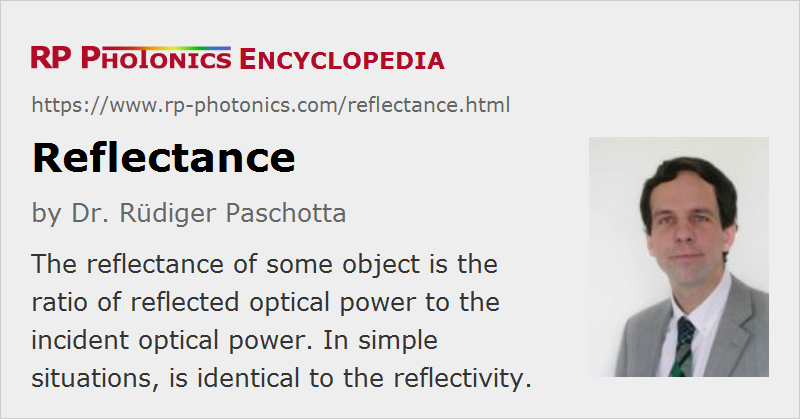Reflectance
Definition: the ratio of reflected optical power to the incident optical power at some reflecting object
German: Reflektanz
How to cite the article; suggest additional literature
Author: Dr. Rüdiger Paschotta
The term reflectance is defined as the ratio of reflected radiant flux (optical power) to the incident flux at a reflecting object – for example, an optical component or system. It generally depends on the direction of incident light and on the optical frequency or wavelength. For polychromatic light, a total reflectance can be calculated with a given optical spectrum as a weighted average.
For reflections at flat unstructured surfaces, instead of reflectance one may also use the term reflectivity. However, the reflectance is a more general term and can be specified in a wider range of situations:
- Reflections can occur on rough surfaces, where light is scattered. One may then specify the hemispherical reflectance, which is based on the total reflected radiant flux, integrated over all directions, or a directional reflectance (see below).
- There are extended objects, where light can penetrate, is internally scattered and thus partially transmitted and partially reflected. The reflectance simply quantifies the amount of light getting back into the half space of the incoming light.
- When light is incident on a transparent plate with parallel surfaces, for example, Fresnel reflections occur on both surfaces. The reflected power can be affected by interference effects, making the reflectance strongly wavelength-dependent.
The results of reflection measurements with spectrophotometers, for example, should usually be called reflectance rather than reflectivity, since the reflections do not need to occur on a single surface. However, the frequent use of reflectivity in such situation does not create the risk of misunderstandings.
Some cases, the term reflectance is used in a non-quantitative manner. For example, there is the phenomenon of Lambertian reflectance, as explained in the article on Lambertian emitters and scatterers.
For objects which exhibit both specular reflection and diffuse reflection (through scattering), one may separately specify reflectance values for those: an “ordinary” reflectance for specular reflections and a hemispherical reflectance for scattering.
Bidirectional Reflectance Distribution Function
The detailed directional properties of reflections can be specified with the bidirectional reflectance distribution function, which is defined as the ratio of reflected radiance and incident irradiance:
It is a function of the directions of both incident and reflected light and is not dimensionless. By integrating this over all observation directions, one obtains the hemispherical reflectance for a given direction of incident light. If the incident light is spread over a range of directions, one may also perform an integration over all directions of incoming light in order to obtain the radiance or the radiant exitance of reflected light.
Questions and Comments from Users
Here you can submit questions and comments. As far as they get accepted by the author, they will appear above this paragraph together with the author’s answer. The author will decide on acceptance based on certain criteria. Essentially, the issue must be of sufficiently broad interest.
Please do not enter personal data here; we would otherwise delete it soon. (See also our privacy declaration.) If you wish to receive personal feedback or consultancy from the author, please contact him e.g. via e-mail.
By submitting the information, you give your consent to the potential publication of your inputs on our website according to our rules. (If you later retract your consent, we will delete those inputs.) As your inputs are first reviewed by the author, they may be published with some delay.
See also: reflectivity, transmittance, absorbance
and other articles in the category general optics
 |





If you like this page, please share the link with your friends and colleagues, e.g. via social media:
These sharing buttons are implemented in a privacy-friendly way!